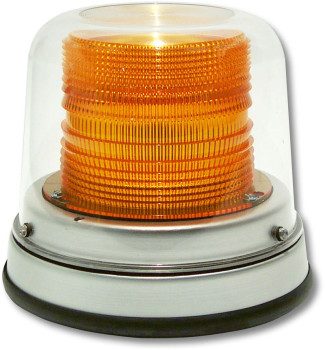Amber Warning Lights
 The Society of Automotive Engineers (SAE) has developed a procedure to test and classify warning light fixtures of every type including, halogen, LED, strobe or incandescent. The categories for the intensity of light are Class I for the brightest light, Class II for mid-range intensity and Class III for lowest intensity.
The Society of Automotive Engineers (SAE) has developed a procedure to test and classify warning light fixtures of every type including, halogen, LED, strobe or incandescent. The categories for the intensity of light are Class I for the brightest light, Class II for mid-range intensity and Class III for lowest intensity.
The SAE has also established warning light standards that relate to dust, moisture, voltage, vibration and electronic standard. The SAE classification provides standards for how oncoming traffic sees lights, such as amber warning lights. Both the dispersion and intensity are considered. With this rating, consumers can be confident they are getting the proper warning light for their needs. This article will address the light output and its direction.
The intensity measurement for all three classifications shows that oncoming traffic gets a stronger warning when more light comes from the fixture. The SAE measurements were taken from five different angles 100 feet from the light source. The angles are in relation to the horizontal/vertical (HV) point which is the center of the lens and are 2.5 and five degrees both up and down from the center point.
The intensity, which is measured in candela, shows how far the light is reaching. The angles show where the light is going and how well it impacts oncoming drivers. A dispersion of 10 degrees at the light is very narrow. Most of the light is at the HV point. A Class I light has 8100 candela at the HV and the 2.5 degrees up and down have 4050 candela. The five degrees up and down have 900 candela.
These numbers show that the light is brighter from a distance, and as the oncoming driver gets closer to the light, it becomes dimmer. This means as the oncoming driver approaches the warning light that is mounted either above or below the windshield of the average car, they will get a good warning at first and, as they pass through the light dispersion, they will still be able to see the perimeter of the vehicle or construction machinery to which the light is attached.
The class of light that is required will also depend on the speed of the vehicle that is having the emergency. A vehicle or machinery that is parked may only require a Class III light to adequately warn other cars. If the vehicle or machinery with an emergency is moving in traffic at a lower speed, a Class II will be adequate. If the vehicle is moving at the same speed as the rest of the traffic, a Class I light is required. Most fleet maintenance directors choose a Class I light because, as already mentioned, the more light, the better the warning.
Class I warning lights are required in many states on all road construction vehicles. The reason for this is because it’s not the number of lights that is important for safety, but the intensity and dispersion according to SAE standards that is important. This gives state and local governments as well as businesses that have fleets of vehicles the information that will help them select lights that meet the standards. Among the lights that meet SAE standards, the ones that are the easiest to install and are the most durable are the most popular.
Installation requirements mean the light is either adaptable to the light that is already on the vehicle or equipment, is easy to install as a new light or needs to be installed by a professional. It should be the correct size for the host vehicle and be easy to use.
Durability means it won’t break or rust, and it is suitable to the function of the host vehicle as well as for the climate where the vehicle is used. The circuit board and lamp should be protected from moisture, shock, vibration, voltage surges and current draw.
